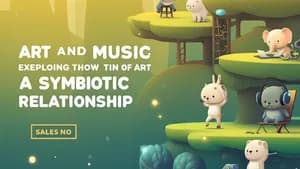Introduction
Imagine a world where the sweeping melody of a symphony transforms into a vibrant canvas, where the rhythmic pulse of a drumbeat guides the dance of a colorful mural. This is the captivating realm of art and music collaborating to tell stories. Throughout history, artists have seamlessly woven together the visual and auditory languages to create experiences that resonate deeply with the human soul. From the medieval illuminated manuscripts to the modern music videos, the power of this partnership continues to enthrall and inspire. This article explores how artists utilize visual elements to complement and enhance musical narratives, highlighting how you can leverage this dynamic interplay to enrich your learning and understanding of both art and music.
Visualizing the Melody: The Marriage of Art and Music
The synergy between art and music is deeply rooted in the human experience. They often speak a universal language that transcends cultural boundaries. Think about the intricate illustrations that accompany classical music scores. These images, meticulously crafted by artists, act as visual interpretations of the music's mood, tempo, and even specific melodic phrases. They provide a visual roadmap for the listener, enhancing the emotional impact and allowing for a deeper understanding of the music's narrative. For example, consider the works of Gustav Klimt, whose paintings often serve as visual counterpoints to the symphonic compositions of Gustav Mahler. Both artists explored themes of life, death, and spirituality, using their unique mediums to create breathtakingly evocative narratives.
As a student, this interplay between art and music can be incredibly enriching. You can actively engage with both disciplines by exploring their connections. Imagine creating your own visual interpretation of a musical piece you're studying. This act of translation allows you to connect with the music on a deeper level, understanding its emotional nuances through a different lens. By pairing your artistic skills with your musical knowledge, you open yourself to a world of creative exploration and self-expression.
Music Videos: A Modern Storytelling Tapestry
In the modern era, music videos have emerged as a powerful platform for visual storytelling. These short films, often accompanied by popular music, leverage the combined strengths of visual and auditory elements to craft engaging narratives. Music videos are not simply visual backdrops; they are integral parts of the storytelling process. They can amplify the emotion of the lyrics, create visual metaphors for the song's themes, or even depict a completely separate story inspired by the music. Take, for instance, the music video for "Bohemian Rhapsody" by Queen. This iconic video, with its captivating visuals and theatrical narrative, has become as iconic as the song itself, contributing to the song's enduring popularity.
This dynamic interplay between visual and auditory elements in music videos offers a wealth of learning opportunities. By analyzing these videos, you can gain valuable insights into the art of storytelling. Consider the role of cinematography, editing, and even costuming in creating a cohesive narrative. How do these elements contribute to the overall message of the video and enhance the listener's understanding of the music? Engaging with these questions allows you to develop a deeper appreciation for the visual language of film and how it interacts with musical composition.
The Power of Visuals in Music Education
The integration of visual elements in music education can dramatically enhance the learning experience. Just as artists use colors, shapes, and textures to communicate ideas, music educators can utilize visual aids to make abstract musical concepts more tangible and engaging. By incorporating visual elements into the classroom, you can help students grasp complex musical ideas, such as rhythm, harmony, and melody, in a more accessible and intuitive way. For instance, instead of simply explaining the concept of a major scale, you could show students a visual representation of the scale on a piano keyboard or use colored blocks to represent different note values in a rhythmic pattern.
Think about how you can incorporate visual elements into your own musical studies. Visual aids such as timelines, diagrams, and even simple drawings can help you grasp complex musical concepts. For example, creating a visual representation of a musical form, such as sonata form, can help you understand the structure of the composition. This visual representation can make the abstract concepts of music more concrete and easier to remember.
The Art of Creative Interpretation: Encouraging Exploration and Expression
The beauty of the interplay between art and music lies in its open-ended nature. There are no definitive answers, only possibilities waiting to be explored. Encourage yourself to interpret music through your own artistic lens. Don't be afraid to break free from traditional approaches and embrace your unique perspective. Visualizing music is a journey of self-discovery, a chance to express your individual understanding and emotions through a different medium.
For example, you might choose to express the joyous energy of a Vivaldi concerto through a vibrant, abstract painting, or create a series of whimsical drawings inspired by the melodic patterns in a Mozart piano sonata. The possibilities are endless. Embrace this freedom to experiment and let your creativity flourish. This approach to learning can be incredibly liberating, empowering you to explore new ideas and develop your own unique artistic voice.
Conclusion
The collaborative narrative of art and music is a testament to the boundless creative potential that lies at the intersection of disciplines. By recognizing and embracing the inherent connections between these two art forms, you can enrich your understanding of both and unlock a world of creative exploration. As you embark on your journey of learning, remember to embrace the power of visual interpretation, allowing your imagination to translate the sounds of music into vibrant visual expressions. This dynamic interplay will not only deepen your appreciation for both art and music but also empower you to express your own unique artistic vision. In this way, you will become a storyteller yourself, weaving together visual and auditory elements to create a truly immersive and unforgettable narrative.

